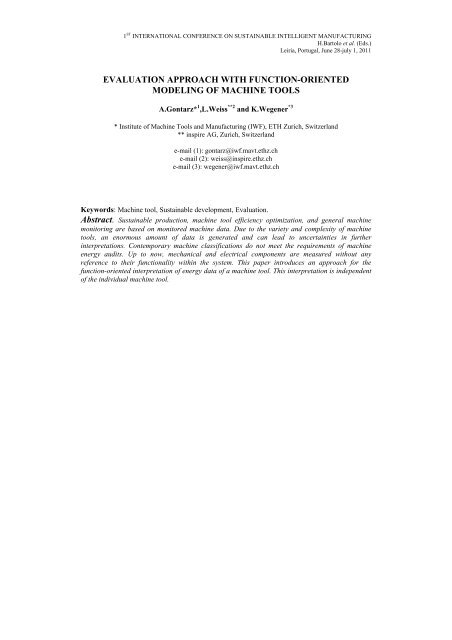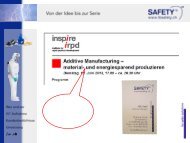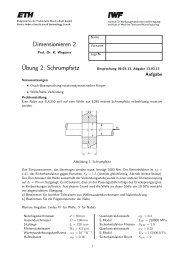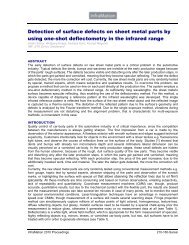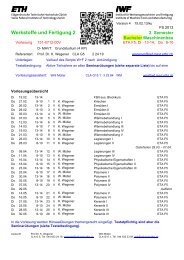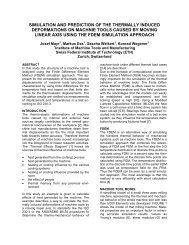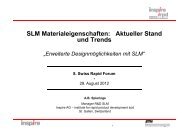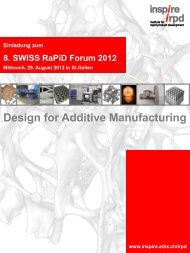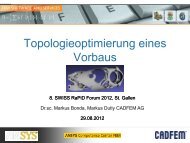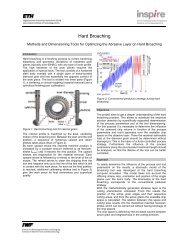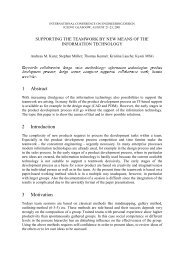evaluation approach with function-oriented modeling of ... - inspire
evaluation approach with function-oriented modeling of ... - inspire
evaluation approach with function-oriented modeling of ... - inspire
You also want an ePaper? Increase the reach of your titles
YUMPU automatically turns print PDFs into web optimized ePapers that Google loves.
1 ST INTERNATIONAL CONFERENCE ON SUSTAINABLE INTELLIGENT MANUFACTURING<br />
H.Bartolo et al. (Eds.)<br />
Leiria, Portugal, June 28-july 1, 2011<br />
EVALUATION APPROACH WITH FUNCTION-ORIENTED<br />
MODELING OF MACHINE TOOLS<br />
A.Gontarz* 1 ,L.Weiss **2 and K.Wegener *3<br />
* Institute <strong>of</strong> Machine Tools and Manufacturing (IWF), ETH Zurich, Switzerland<br />
** <strong>inspire</strong> AG, Zurich, Switzerland<br />
e-mail (1): gontarz@iwf.mavt.ethz.ch<br />
e-mail (2): weiss@<strong>inspire</strong>.ethz.ch<br />
e-mail (3): wegener@iwf.mavt.ethz.ch<br />
Keywords: Machine tool, Sustainable development, Evaluation.<br />
Abstract. Sustainable production, machine tool efficiency optimization, and general machine<br />
monitoring are based on monitored machine data. Due to the variety and complexity <strong>of</strong> machine<br />
tools, an enormous amount <strong>of</strong> data is generated and can lead to uncertainties in further<br />
interpretations. Contemporary machine classifications do not meet the requirements <strong>of</strong> machine<br />
energy audits. Up to now, mechanical and electrical components are measured <strong>with</strong>out any<br />
reference to their <strong>function</strong>ality <strong>with</strong>in the system. This paper introduces an <strong>approach</strong> for the<br />
<strong>function</strong>-<strong>oriented</strong> interpretation <strong>of</strong> energy data <strong>of</strong> a machine tool. This interpretation is independent<br />
<strong>of</strong> the individual machine tool.
A.Gontarz, L.Weiss and K.Wegener<br />
1 INTRODUCTION<br />
Energy consumption is a relevant factor in machine tool operation in several respects. First<br />
<strong>of</strong> all, the vast majority <strong>of</strong> energy consumed by a machine tool results as a thermal impact on<br />
the machine; thermal distortion is consequently a primary cause for inaccuracy [1]. Second,<br />
this thermal impact demands supplementary measures for heat transfer and thermal<br />
stabilization <strong>of</strong> the machining process and machine tool [2]. Third, energy is and will continue<br />
to be a cost factor in manufacturing [3].<br />
Unfortunately, neither the machine tool manufacturers nor their customers have a clear<br />
picture <strong>of</strong> the energy consumption <strong>of</strong> machines and production lines today [4]. On the grounds<br />
<strong>of</strong> increased competitive pressure, rising prices for energy, possible legal requirements, and<br />
further optimizations, a detailed picture <strong>of</strong> the energy consumption <strong>with</strong>in a machine tool<br />
production system is necessary. Systematic measurements <strong>of</strong> machine tools’ overall energy<br />
consumption can also contribute to cost awareness and provide a basis for decision-making in<br />
manufacturing. Within the life cycle <strong>of</strong> machine tools, the use phase is the most dominant stage<br />
for energy consumption [5]. The energetic <strong>evaluation</strong>s in the use phase are constrained by the<br />
assessment <strong>of</strong> machine tool components and their energetic behavior. This paper introduces a<br />
top down <strong>evaluation</strong> <strong>approach</strong> for the energetic behavior <strong>of</strong> a machine tool by applying a<br />
<strong>function</strong>al <strong>modeling</strong> <strong>of</strong> the system. This method aims to characterize a complex machine tool system<br />
and facilitates optimization and energy efficiency improvement.<br />
2 STATE OF THE ART<br />
A universal method <strong>of</strong> capturing and interpreting the resource and energy consumption is<br />
not yet available. The diversity and complexity <strong>of</strong> machine tools make it difficult to propose a<br />
reasonable method. Comparability <strong>of</strong> the energy consumption and energy efficiency <strong>of</strong><br />
different process technologies or machine tool configurations can hardly be identified by<br />
applying a single component <strong>evaluation</strong>.<br />
A comprehensive comparability can set a basis for decision-making <strong>with</strong>in manufacturing,<br />
i.e., type and quantity <strong>of</strong> machine tools. Brinksmeier [6] and Kuhrke [7] represent a bottom up<br />
<strong>approach</strong> by taking into account direct process parameters such as cutting force or depth in<br />
relation to energy consumption. This <strong>approach</strong> represents a universal and comparable physical<br />
<strong>evaluation</strong> ground. Direct process energy is not the only energy cluster in a machine tool<br />
system, however. Machine internal energy and machine external peripherals are important<br />
consumers and relativize this basis for comparison. Dietmair [4] has shown that the major<br />
share <strong>of</strong> a machine tool’s energy consumption is load-independent and used by peripheral<br />
equipment.<br />
Own power measurements (Fig.1) show that the chip removing energy <strong>of</strong> a typical hard<br />
turning process has minor impact on the total energy consumption. In other cases, the<br />
auxiliaries that disprove a common energetic comparison on the component level dominate the<br />
total energy consumption. From these findings, a comparison based on the chip-removal<br />
energy is not applicable.
A.Gontarz, L.Weiss and K.Wegener<br />
Relevant direct value adding <strong>function</strong>s <strong>of</strong> the machine tool must be identified for allembracing<br />
energetic optimization, thus defining the favored goal <strong>function</strong>ality such as chip<br />
removal or direct process cooling. Auxiliary components, <strong>of</strong>ten <strong>with</strong> a constant load and power<br />
consumption, fulfill essential <strong>function</strong>ality, but <strong>with</strong>out proportionality to added value. The<br />
goal is to define their share and amount in order to minimize the power consumption to the<br />
essential physical minimum. Furthermore, their <strong>function</strong>ality might be substituted by<br />
corresponding technologies or proper dimensions in order to increase energy efficiency.<br />
Figure 1 Power measurement <strong>of</strong> machining a drive shaft on a<br />
turning machine <strong>with</strong> process cooling by compressed air<br />
An abstract view <strong>of</strong> the overall machine tool system, including the peripheral consumers,<br />
could clear up the <strong>evaluation</strong> statements and conclusions made from the component power<br />
measurements. These <strong>evaluation</strong> statements can be reached by detaching from the component<br />
to a <strong>function</strong>al view <strong>of</strong> the system. It is an abstract view detached from technical solutions or<br />
implemented components.<br />
3 CONCEPT OF THE FUNCTIONAL ENERGY EVALUATION<br />
Function orientation is primarily represented in the development <strong>of</strong> complex technical<br />
systems such as in the automotive sector. A review tool is considered to meet consumers’<br />
requirements. The development and testing <strong>of</strong> the defined <strong>function</strong>alities can be challenging<br />
since complex mechatronic or hybrid systems such as vehicles, buildings, and machine tools<br />
fulfill their defined <strong>function</strong>ality, employed by various consumers. Regarding technical<br />
specification, the <strong>evaluation</strong> <strong>of</strong> the <strong>function</strong>ality and its attributes, i.e., energy consumption,<br />
shall be done on the component level.<br />
A <strong>function</strong> is defined as the outcome, task, action, or attribute <strong>of</strong> an object or component<br />
[8]. The <strong>function</strong>al description is general and independent <strong>of</strong> the system design.<br />
Corresponding components can be mapped to one <strong>of</strong> five main machine <strong>function</strong>s, as<br />
illustrated below for a generic sample machine tool.<br />
The assignment or mapping <strong>of</strong> mechanical/electrical machine components to the <strong>function</strong>s<br />
is specific for each case. Fig.2 shows this transition from total energy consumption via
A.Gontarz, L.Weiss and K.Wegener<br />
<strong>function</strong>al level and <strong>function</strong>al mapping to mechanical/electrical component level <strong>with</strong> hereby<br />
defined five main machine <strong>function</strong>s.<br />
Main machine <strong>function</strong>s<br />
Machine components<br />
Machining (machine<br />
process, motion and<br />
control)<br />
Process conditioning and<br />
cooling<br />
Tool and workpiece<br />
handling<br />
24 V supply<br />
230V supply<br />
E/R module supply<br />
Monitoring module<br />
CNC Total<br />
Chip conveyor<br />
Mist collector<br />
Hydraulic pump<br />
Fluid application pump<br />
Waste handling<br />
Spindle cooling pump<br />
Machine conditioning and<br />
cooling<br />
Cooling fan 1<br />
CNC air-conditioning 1<br />
Compressed Air<br />
Figure 2 Main machine tool <strong>function</strong>s and its example<br />
components for a lathe<br />
The main machine tool <strong>function</strong>s on the first level are described in the sequel:<br />
3.1 Machining (machining process, motion and control)<br />
This <strong>function</strong> summarizes the target <strong>function</strong> <strong>of</strong> the machine tool, i.e., the energy<br />
consumption needed to realize the primary machining process. It comprises for instance the<br />
realization <strong>of</strong> cutting velocity, <strong>of</strong> an electro-discharge process, or <strong>of</strong> laser beam for cutting. It<br />
also includes machine motion needed during machining, e.g., the energy for the relative<br />
movement between a tool and a workpiece. As in most cases, this <strong>function</strong> is closely linked<br />
<strong>with</strong> and driven by a numerical control. It includes Programmable Logic Controller (PLC),<br />
monitoring systems, and measuring systems, except the cooling <strong>of</strong> these parts. Typical<br />
mechanical and electrical components for the <strong>function</strong> 'machining process, motion and control'<br />
are linear and rotary axes <strong>of</strong> a machining center <strong>with</strong> their drives, and the numerical control<br />
system including the user interface.<br />
3.2 Process Conditioning and Cooling<br />
This <strong>function</strong>, which comprises conditioning, cooling, and heating, is process related. It<br />
keeps the temperature and other relevant conditions <strong>of</strong> the working volume, the tools, the<br />
fixtures and/or the workpieces <strong>with</strong>in limits. Process conditioning may be seen as value adding<br />
<strong>function</strong>. This <strong>function</strong> is directly dependent on the machining process to keep it stable, e.g.,<br />
lubrication for grinding and die lubrication for forming. Supply and consequently energy<br />
consumption may be dependent on the value adding <strong>function</strong>ality. Furthermore, there might be
A.Gontarz, L.Weiss and K.Wegener<br />
some relation to machine cooling (see 3.5) and/or heating. In some cases, the two <strong>function</strong>s<br />
can<br />
hardly be distinguished from each other. A guideline can be the generation <strong>of</strong> direct added<br />
value, i.e. surface quality, or auxiliary <strong>function</strong>s, i.e., cooling fan for electronics, respectively.<br />
Typical mechanical components for the <strong>function</strong> "process conditioning and cooling" are<br />
cooling pumps or compressed air if used for process cooling.<br />
3.3 Workpiece and Tool Handling<br />
'Workpiece and tool handling' may consist <strong>of</strong> changing, grasping, clamping, handling, and lifting<br />
<strong>of</strong> the workpiece, the tool, or both; furthermore, it includes the infeed <strong>of</strong> raw material and the<br />
measurement <strong>of</strong> workpieces in the machine tool. Typical mechanical components for handling<br />
workpieces are robots, hydraulic fixtures, and pneumatic chucks. Typical mechanical components<br />
for tool handling include a turret <strong>of</strong> a turning machine and tool changer <strong>of</strong> a machining center. In<br />
some cases, this <strong>function</strong> might be separated into two sub<strong>function</strong>s: 'workpiece' handling and 'tool'<br />
handling.<br />
3.4 Waste Handling<br />
This <strong>function</strong> summarizes the handling <strong>of</strong> chips, cutting fluids (such as separation and<br />
filtering), handling <strong>of</strong> dust and fumes, and handling <strong>of</strong> dirt, including the protection <strong>of</strong><br />
machine components against ingress <strong>of</strong> harmful waste, i.e., fluids or chips. Typical mechanical<br />
components for the <strong>function</strong> 'waste handling' consist <strong>of</strong> a chip conveyor, filter systems, and<br />
exhaust systems. A common measure to protect components is to seal air for motors and<br />
measuring systems.<br />
3.5 Machine Cooling and Conditioning<br />
This <strong>function</strong> summarizes all cooling and heating that is independent from the machining<br />
process. The machine cooling and conditioning does not add value to the machining process<br />
itself. It is applied to keep the temperature <strong>of</strong> the control cabinet <strong>with</strong>in operational limits and<br />
ensure that components are not damaged or distorted. In some cases, this <strong>function</strong> can overlap<br />
<strong>with</strong> the process cooling and conditioning. One way to distinguish machine cooling from<br />
process cooling is to consider the location. Process cooling is directly connected to the<br />
workpiece and process area, whereas machine cooling and conditioning, in most cases, do not<br />
have a direct contact to the machine lubrication or active parts (e.g. workpiece or chuck).<br />
4 COMPONENTS MAPPING FOR FUNCTIONAL EVALUATION<br />
Various machine tool systems can be characterized based on the above-mentioned<br />
definition and classification <strong>of</strong> these five generalized <strong>function</strong>s. The main machine <strong>function</strong>s,<br />
i.e., machine motion <strong>with</strong> the generation <strong>of</strong> relative movement <strong>of</strong> axes, can be realized by<br />
different technologies, quantity, and the type <strong>of</strong> components. They are independent <strong>of</strong> the<br />
individual machine tool configuration and dimensions. An abstract view <strong>of</strong> the system can<br />
therefore help to compare similar but not identical machine tool configurations (Fig.2).
A.Gontarz, L.Weiss and K.Wegener<br />
Here<strong>with</strong> the attributes <strong>of</strong><br />
each energetic relevant<br />
component, that is, power consumption, must be<br />
summarized and clustered Specific turning<br />
according to the <strong>function</strong>al<br />
machine<br />
component mapping (Fig.3).<br />
Machining (machining<br />
process, motion and<br />
control)<br />
Process conditioning and<br />
cooling<br />
Workpiece handling and<br />
Tool handling<br />
Machine cooling and<br />
conditioning<br />
Waste handling<br />
...<br />
CNC Total<br />
...<br />
1<br />
Chip conveyor<br />
Pulse lubrication 1<br />
Mist collector<br />
Hydraulic system<br />
1<br />
Coolant pump<br />
0.5<br />
0.25<br />
... ...<br />
1<br />
1<br />
0.25<br />
Figure 3 Functional mapping <strong>with</strong> a matrix<br />
The mapping <strong>of</strong> the components and their contributions to their intended <strong>function</strong> has to<br />
follow general rules, but it must be done individually. Therefore, it needs a methodological<br />
<strong>approach</strong>. The component mapping <strong>with</strong>in the <strong>evaluation</strong> may differ while it does not influence<br />
the total power and energy consumption.<br />
Most components are directly related to one <strong>function</strong>; for instance, a machining spindle is<br />
part <strong>of</strong> machine motion. In the case <strong>of</strong> the coolant pump (Fig.3), it contributes not only to<br />
process cooling but to machine cooling and waste handling by washing away the chips as well.<br />
Consequently, the energy consumption <strong>of</strong> the coolant pump must be split into these three<br />
<strong>function</strong>s, based on measurement or – more frequently – on estimation. A machine tool energy<br />
audit is a good way to estimate these shares. The assigned share <strong>of</strong> the components defines the<br />
ensuing <strong>evaluation</strong> and optimization. Summing up, the <strong>function</strong>al energy <strong>evaluation</strong> can be<br />
structured into a general part, which is valid for all machine tools, and a specific part, which<br />
represents the individual machine tool configuration (Fig.4).
A.Gontarz, L.Weiss and K.Wegener<br />
Figure 4 Functional <strong>evaluation</strong> overview corresponding to Fig. 2 and Fig. 3<br />
5 EXAMPLE OF THE FUNCTION ORIENTED EVALUATION<br />
Different machine tools were assessed according to the introduced <strong>function</strong>al <strong>evaluation</strong>.<br />
There<strong>with</strong> not only milling or grinding machines match this introduced scheme, but also laser<br />
cutting or EDM machines. The shown measurement <strong>of</strong> a typical turning machine, which<br />
consists <strong>of</strong> the components represented in Fig.2, is used as a standard example for this<br />
<strong>evaluation</strong>. The measured reference process, which is an automotive driveshaft, assigns the<br />
energetic behavior <strong>of</strong> the machine tool. The mean power values <strong>of</strong> each component during one<br />
part machining cycle are summarized and clustered according to the <strong>function</strong>al mapping in Fig.<br />
3 and shown <strong>with</strong>in the <strong>function</strong>al <strong>evaluation</strong> in Fig. 5.<br />
Figure 5 Functional <strong>evaluation</strong> <strong>of</strong> a<br />
drive shaft on a turning machine<br />
Figure 6 Functional <strong>evaluation</strong> <strong>of</strong> a<br />
laser machine<br />
The <strong>evaluation</strong> shows a relatively minor share <strong>of</strong> power consumption <strong>of</strong> the main, value<br />
adding <strong>function</strong> 'machining', as expected from Fig.1, whereby the supporting auxiliary<br />
<strong>function</strong>s are dominant. Furthermore, 'process cooling and the machine cooling' dominate in<br />
this case.<br />
The disproportion between these <strong>function</strong>s and the primary <strong>function</strong> ‘machining’, representing<br />
the energy initially brought into the machining process, puts some doubt on the efficiency <strong>of</strong><br />
these <strong>function</strong>s. The respective components might be oversized; the technologies and/or the<br />
subsystem design might be inefficient. A different but not typical <strong>evaluation</strong> picture results for<br />
the case <strong>of</strong> dry machining <strong>with</strong> excessive feed rates and cutting depths, boosting the share <strong>of</strong><br />
the main <strong>function</strong> ‘machining’ but leading to massive tool wear in the case <strong>of</strong> turning<br />
processes, as internal measurements have shown<br />
Another <strong>function</strong>al <strong>evaluation</strong> represents a typical picture <strong>of</strong> a laser cutting machine<br />
(Fig.6). The main machine <strong>function</strong> is represented by the CNC drives, the high frequency (HF)<br />
generator, and the process gas turbo blower. In this machine configuration, the process cooling<br />
and the tool and/or part handling <strong>function</strong> are not applicable, as there is no need and no
A.Gontarz, L.Weiss and K.Wegener<br />
consumer to fulfill this <strong>function</strong>. In the event <strong>of</strong> an automatic workpiece handling, this <strong>function</strong><br />
must also be assessed. The machine cooling peripheral is dominant, whereas the waste<br />
handling <strong>function</strong> is represented by a constantly running exhauster. This <strong>evaluation</strong> can<br />
therefore provide an energetic comparison <strong>of</strong> another machine tool technology that provides<br />
the same application, such as metal sheet cutting by punching. This <strong>approach</strong> is presented in<br />
the ISO/WD 14955-1 standard <strong>with</strong> additional definitions and examples as well.<br />
6 CONCLUSION AND OUTLOOK<br />
The <strong>function</strong>al <strong>oriented</strong> energy <strong>evaluation</strong> represents an <strong>approach</strong> <strong>of</strong> a conceptual review <strong>of</strong><br />
machine tools. It helps to understand the energetic behavior <strong>of</strong> a machine tool and establishes a<br />
common basis for comparison, energetic <strong>evaluation</strong>s, and further optimizations. The<br />
assessment is made based on total energy consumption and data acquisition, which is attributed<br />
to defined machine <strong>function</strong>s. Therefore, the <strong>function</strong>al view can be seen as a tool, helping to<br />
provide a clear depiction <strong>of</strong> value adding <strong>function</strong>s, as well as a sensible clustering <strong>of</strong> data<br />
acquired from a machine tool production system <strong>with</strong>out any disadvantages or loss <strong>of</strong><br />
information. The advantage is to get a simple, easy to understand picture <strong>of</strong> the energy<br />
consumption. A second point is the obviousness <strong>of</strong> proportions, leading to the potential field<br />
for optimization. Another advantage is the possibility to compare different assemblies <strong>of</strong><br />
components, either for one machine tool or the comparison <strong>of</strong> various machine tools, e.g., in<br />
decision-making for manufacturing. As it is related to known <strong>function</strong>-<strong>oriented</strong> methods in<br />
value analysis, target costing, or product development and testing, the concept is easy to adapt<br />
and can be implemented in an industrial R&D environment as a complementary tool for energy<br />
assessments.<br />
REFERENCES<br />
[1] Weck, M., Reduction and Compensation <strong>of</strong> Thermal Errors in Machine Tools, Annals <strong>of</strong><br />
the CIRP, 44/2:589-598, 1995.<br />
[2] Bryan, J., International Status <strong>of</strong> Thermal Error Research, Annals <strong>of</strong> the CIRP, 39/2:645-<br />
656, 1990.<br />
[3] Agency, I. E. "World Energy Outlook 2008" from http://www.worldenergyoutlook.org/,<br />
2010.<br />
[4] Dietmair, A., Verl A., 2009, "Energy Consumption Forecasting And Optimisation for<br />
Tool Machines", MM Science Journal 3: 63-67, 2009.<br />
[5] Züst, R., S. Züst, 2009, Ecodesign-Potenzialanalyse in der Schweizer MEM-Industrie -<br />
eine explorative Studie, Zürich, Swissmem: 7.<br />
[6] Brinksmeier, et al., "Improving ecological aspects <strong>of</strong> the grinding process by effective<br />
waste management" Journal <strong>of</strong> Materials Processing Technology 44(3-4): 171-178, 1994.
A.Gontarz, L.Weiss and K.Wegener<br />
[7] Kuhrke, B., S. Schremns, et al., Methodology to access the energy consumption <strong>of</strong> cutting<br />
machine tools. LCE 2010 - 17th International Conference on Life Cycle Engineering.<br />
Hefei, China, 2010.<br />
[8] Pahl, G., Beitz, W., Konstruktionslehre, Grundlage erfolgreicher Produktentwicklung –<br />
Methoden und Anwendung, 5.Auflage, Springer, 2002.


